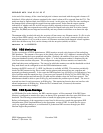“full”, “incremental”, or “delta”. Full backups record the full contents of the database at a point in time.
Incremental backups record all the changed data since the last full backup. Delta backups record only the
data that has changed since the most recent backup (of any type). Obviously, a full backup is necessary as
a starting point in the recovery of a database. Incremental and delta backups help reduce the number of
transaction logs that must be retrieved and applied during a restore operation.
Consider a site that keeps the following schedule for backing up a database:
Sunday: full
Monday: delta
Tuesday: delta
Wednesday: incremental
Thursday: delta
Friday: delta
Saturday: delta
Under this scheme, if the database fails between the Thursday and Friday backups, only a few backup
images would be needed for a restore: Sunday's full backup is needed as a starting point. Wednesday's
incremental backup includes all changes since Sunday, so it makes retrieval of Monday's and Tuesday's
backups unnecessary. Beyond that, Thursday's delta backup is needed, as well as any transaction logs
archived after Thursday's backup. So the needed images are: Sunday, Wednesday, Thursday, and only
those logs between Thursday's backup and the point of failure.
The way DB2's backup and restore commands are implemented makes restoration simple. Basically, only
the latest backup image needs to be specified. DB2 records the backup history in each backup, so it can
determine which images and logs are necessary. Assuming an automated method is used for backup
storage and retrieval, it can also fetch the images and restore from them. See the DB2 Data Recovery
Guide for details.
15.1.2.1. Configuring DB2 for Online Backup
Several steps must be taken to prepare a DB2 database for online backup. Initially, a newly-created
database is configured to perform offline backups. The database's configuration must be updated to
indicate that subsequent backups should be made online. An initial, offline backup must then be made as
a starting point for the backup process. The database will be inoperative until this initial full backup is
completed. So an outline of the major steps to set up a database for online backup is:
1. Configure backup software and make certain data can be archived into it and retrieved from it.
2. Update the database configuration to enable log archiving, this will place the database in "backup
pending" state.
3. Perform initial full, offline backup (database returns to normal state).
4. Schedule subsequent backups using cron.
To start a DB2 backup, invoke the “db2 backup” command line interface. Typically, the administrator
would put this command into a script along with any necessary parameters to indicate the type of backup,
destination, etc. The script would then be invoked from cron.
For details on configuring DB2 for backup, administrators should consult the DB2 Data Recovery Guide
as well as the documentation for their backup software.
HPSS Management Guide November 2009
Release 7.3 (Revision 1.0) 358


















